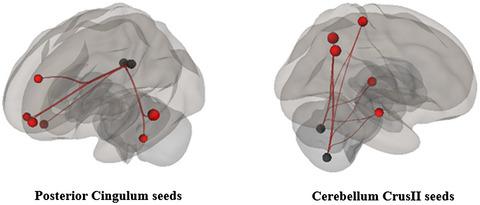当前位置:
X-MOL 学术
›
J. Neurosci. Res.
›
论文详情
Our official English website, www.x-mol.net, welcomes your feedback! (Note: you will need to create a separate account there.)
Changes in resting‐state functional brain connectivity associated with head impacts over one men’s semi‐professional soccer season
Journal of Neuroscience Research ( IF 4.2 ) Pub Date : 2020-10-21 , DOI: 10.1002/jnr.24742 Hélène Cassoudesalle 1, 2 , Adrien Petit 1 , Sandra Chanraud 3 , Hervé Petit 2 , Jérôme Badaut 4 , Igor Sibon 3 , Patrick Dehail 1, 2
Journal of Neuroscience Research ( IF 4.2 ) Pub Date : 2020-10-21 , DOI: 10.1002/jnr.24742 Hélène Cassoudesalle 1, 2 , Adrien Petit 1 , Sandra Chanraud 3 , Hervé Petit 2 , Jérôme Badaut 4 , Igor Sibon 3 , Patrick Dehail 1, 2
Affiliation

|
Soccer, as a contact sport, exposes players to repetitive head impacts, especially through heading the ball. The question of a long‐term brain cumulative effect remains. Our objective was to determine whether exposure to head impacts over one soccer season was associated with changes in functional brain connectivity at rest, using magnetic resonance imaging (MRI). In this prospective cohort study, 10 semi‐professional men soccer players, aged 18–25 years, and 20 age‐matched men athletes without a concussion history and who do not practice any contact sport were recruited in Bordeaux (France). Exposure to head impacts per soccer player during competitive games over one season was measured using video analysis. Resting‐state functional magnetic resonance imaging data were acquired for both groups at two times, before and after the season. With a seed‐based analysis, resting‐state networks that have been intimately associated with aspects of cognitive functioning were investigated. The results showed a mean head impacts of 42 (±33) per soccer player over the season, mainly intentional head‐to‐ball impacts and no concussion. No head impact was found among the other athletes. The number of head impacts between the two MRI acquisitions before and after the season was associated with increased connectivity within the default mode network and the cortico‐cerebellar network. In conclusion, our findings suggest that the brain functioning changes over one soccer season in association with exposure to repetitive head impacts.
中文翻译:

在一个男子半职业足球赛季中与头部撞击相关的静息状态功能性大脑连接的变化
足球作为一项接触性运动,让球员受到重复的头部撞击,尤其是通过头球撞击。长期大脑累积效应的问题仍然存在。我们的目标是使用磁共振成像 (MRI) 确定在一个足球赛季中头部撞击的暴露是否与休息时大脑功能连接的变化有关。在这项前瞻性队列研究中,在波尔多(法国)招募了 10 名年龄在 18-25 岁之间的半职业男子足球运动员和 20 名没有脑震荡史且不从事任何接触性运动的同龄男子运动员。使用视频分析测量在一个赛季的竞技比赛中每个足球运动员头部撞击的暴露情况。在赛季前后两次采集两组的静息状态功能磁共振成像数据。通过基于种子的分析,研究了与认知功能方面密切相关的静息状态网络。结果显示,本赛季每位足球运动员的平均头部撞击为 42 (±33) 次,主要是有意的头对球撞击,没有脑震荡。在其他运动员中没有发现头部撞击。赛季前后两次 MRI 采集之间的头部撞击次数与默认模式网络和皮质-小脑网络内的连通性增加有关。总之,我们的研究结果表明,大脑功能在一个足球赛季中会发生变化,这与重复头部撞击有关。结果显示,本赛季每位足球运动员的平均头部撞击为 42 (±33) 次,主要是有意的头对球撞击,没有脑震荡。在其他运动员中没有发现头部撞击。赛季前后两次 MRI 采集之间的头部撞击次数与默认模式网络和皮质-小脑网络内的连通性增加有关。总之,我们的研究结果表明,大脑功能在一个足球赛季中会发生变化,这与重复头部撞击有关。结果显示,本赛季每位足球运动员的平均头部撞击为 42 (±33) 次,主要是有意的头对球撞击,没有脑震荡。在其他运动员中没有发现头部撞击。赛季前后两次 MRI 采集之间的头部撞击次数与默认模式网络和皮质-小脑网络内的连通性增加有关。总之,我们的研究结果表明,大脑功能在一个足球赛季中会发生变化,这与重复头部撞击有关。赛季前后两次 MRI 采集之间的头部撞击次数与默认模式网络和皮质-小脑网络内的连通性增加有关。总之,我们的研究结果表明,大脑功能在一个足球赛季中会发生变化,这与重复头部撞击有关。赛季前后两次 MRI 采集之间的头部撞击次数与默认模式网络和皮质-小脑网络内的连通性增加有关。总之,我们的研究结果表明,大脑功能在一个足球赛季中会发生变化,这与重复头部撞击有关。
更新日期:2020-12-20
中文翻译:

在一个男子半职业足球赛季中与头部撞击相关的静息状态功能性大脑连接的变化
足球作为一项接触性运动,让球员受到重复的头部撞击,尤其是通过头球撞击。长期大脑累积效应的问题仍然存在。我们的目标是使用磁共振成像 (MRI) 确定在一个足球赛季中头部撞击的暴露是否与休息时大脑功能连接的变化有关。在这项前瞻性队列研究中,在波尔多(法国)招募了 10 名年龄在 18-25 岁之间的半职业男子足球运动员和 20 名没有脑震荡史且不从事任何接触性运动的同龄男子运动员。使用视频分析测量在一个赛季的竞技比赛中每个足球运动员头部撞击的暴露情况。在赛季前后两次采集两组的静息状态功能磁共振成像数据。通过基于种子的分析,研究了与认知功能方面密切相关的静息状态网络。结果显示,本赛季每位足球运动员的平均头部撞击为 42 (±33) 次,主要是有意的头对球撞击,没有脑震荡。在其他运动员中没有发现头部撞击。赛季前后两次 MRI 采集之间的头部撞击次数与默认模式网络和皮质-小脑网络内的连通性增加有关。总之,我们的研究结果表明,大脑功能在一个足球赛季中会发生变化,这与重复头部撞击有关。结果显示,本赛季每位足球运动员的平均头部撞击为 42 (±33) 次,主要是有意的头对球撞击,没有脑震荡。在其他运动员中没有发现头部撞击。赛季前后两次 MRI 采集之间的头部撞击次数与默认模式网络和皮质-小脑网络内的连通性增加有关。总之,我们的研究结果表明,大脑功能在一个足球赛季中会发生变化,这与重复头部撞击有关。结果显示,本赛季每位足球运动员的平均头部撞击为 42 (±33) 次,主要是有意的头对球撞击,没有脑震荡。在其他运动员中没有发现头部撞击。赛季前后两次 MRI 采集之间的头部撞击次数与默认模式网络和皮质-小脑网络内的连通性增加有关。总之,我们的研究结果表明,大脑功能在一个足球赛季中会发生变化,这与重复头部撞击有关。赛季前后两次 MRI 采集之间的头部撞击次数与默认模式网络和皮质-小脑网络内的连通性增加有关。总之,我们的研究结果表明,大脑功能在一个足球赛季中会发生变化,这与重复头部撞击有关。赛季前后两次 MRI 采集之间的头部撞击次数与默认模式网络和皮质-小脑网络内的连通性增加有关。总之,我们的研究结果表明,大脑功能在一个足球赛季中会发生变化,这与重复头部撞击有关。



























 京公网安备 11010802027423号
京公网安备 11010802027423号